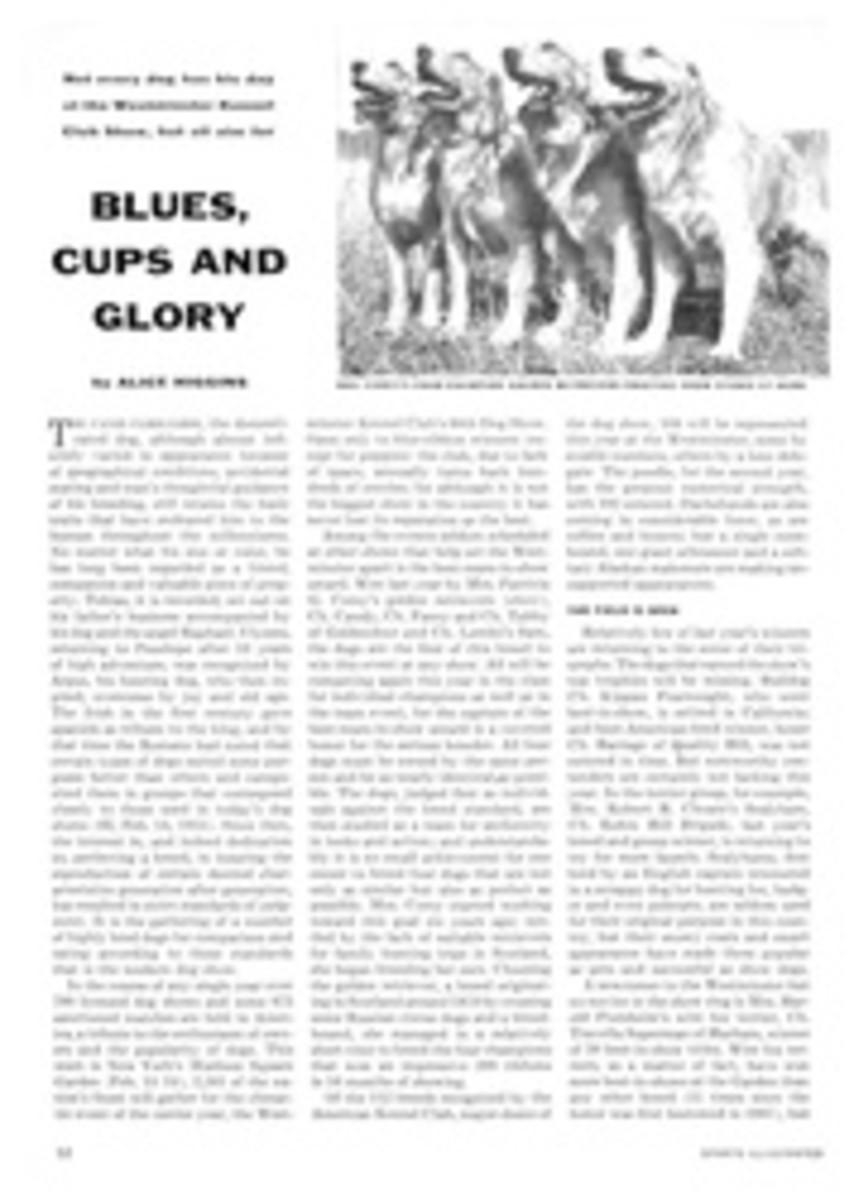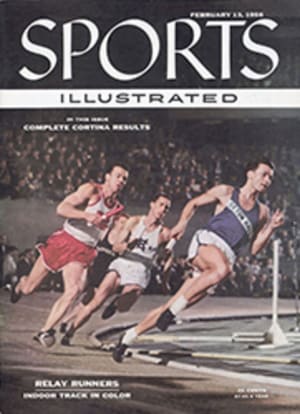
BEAU OF CORTINA
The Olympics' only triple gold medalist, and beyond question the world's greatest skier in 1956, is a 20-year-old Austrian who combines the muscles of a champion with the sensitivity of an artist and the glamour of a movie star.
Anton (Toni) Sailer's face is known on every Alpine slope. At Cortina Sailer (rhymes with miler) is likened to Tyrone Power, but his shyness and reticence are as striking as his good looks, and he might be more aptly called the Li'l Abner of the Tyrolean hills.
Among the taciturn mountain folk of Kitzbühel, his home, to whom snow is as certain an ingredient of life as earth to a farmer, he is accepted as peerless, though no such compliment would be paid to his face.
If this winner of the giant slalom, special slalom and downhill races has a secret, it is his familiarity with—and sensitivity to—snow. His victories have been made the easier at Cortina because of the difficulties, natural and man-made. Snow has been scarce enough to make runs more dangerous than usual; moreover, by general consent, the Cortina slalom course has been the most difficult in Olympic history. The snow was icy, the gradients steep, 70 gates had been placed on the first run and no fewer than 98 on the second. Sailer won his triple crown not merely by going faster than the others. When others were falling, he knew when to go slow: not through familiarity with the courses, but by the feel of the snow through his skis.
When Sailer is asked why he won, he tends to shrug his shoulders and say, "Well, I went faster." Zeno Colo, the former Italian gold-medal skier, who has carefully watched all the ski events here, is more articulate about Sailer:
"He is gentle with the snow. He is never rough to his skis. He has an immediate, faster-than-thought reaction to varying snow conditions. So he snatches an advantage a split second sooner than anyone else, which takes him 10 yards ahead while the others are still wondering."
The Austrian, Anderl Molterer, and the Frenchman, Adrien Duvillard, were the only two to get close to Sailer. But they fell, while Sailer, always under control, surged unfalteringly to the finish line. Says Colo:
"His every movement is controlled, not by reason, but by lightning subconscious reflex. In the language that the skis talk through the feet, to the legs and body. It is a language unknown to most men and women, but it is the whisper Sailer understands best."
Sailer himself would consider this analysis of his genius a trifle poetical. Yet he admits, "One doesn't notice one's reactions, nor how they arise. One just must have them. Skiing is really a test of subconscious reactions."
Toni's coach, Fred Rosner, and Edgar Fried, the bespectacled head of the Austrian delegation to Cortina, admit there is nothing they can teach the boy. All they can do is keep a watchful eye on his diet (he drinks wine twice a day, before and during competition, and for breakfast fancies a mixture of milk, honey and sugar, which he stirs with a spoon for a full five minutes) and ensure he has enough sleep. Says Fried:
"He trains just like the other boys. We let them work as they like. We don't want a unified style, we want each to develop his individual ability." Then he adds, with typical Kitzbühel understatement, "We are really quite pleased with Sailer."
Toni, who now weighs 174 pounds and measures exactly 6 feet, was born on November 17, 1935, and two years later at Kitzbühel had slipped his feet into a pair of skis.
He learned the rudiments at the Kitzbühel Ski Club. He has two older sisters, and one of them, Rosi, used to go skiing with Christian Pravda, one of Austria's greatest champions. Through Rosi, Pravda took an interest in Toni. Sailer made an idol of Pravda, and still does, although he is today an idol to a greater number of Europeans than Pravda ever was.
His father has a glass shop, and Toni has worked there since leaving a Gewerbeschule, a handicrafts school in Kitzbühel. But he has all the time he needs for sport in summer and winter. When he is not fashioning glass windows, he plays soccer, swims and is a local tennis star.
"I love music," he confessed, and one wondered if Wagner was his inspiration. But it turned out he likes yodeling and bebop.
"In the summer," he says, "I go to bed when I feel tired," but when the first snows come this idyllic Dogpatch life gives way to sternest training. No coach compels him, only ambition— or loyalty to Kitzb√ºhel and Austria.
This season, training started with four hours daily, for seven days, with the Kitzbühel Club at Weissee, some 30 miles away. This was to be followed by intensive individual training at home. But no snow came to Kitzbühel, so it was not until the second week of December that Sailer put on skis again, this time at Cervinia in Italy, with the Austrian Olympic squad, for another four hours a day for 10 days. Then back to Kitzbühel, where there were five merciful days of snow. Still, Sailer came back to Cortina with only 85 hours of training this season behind him.
Yet when Toni stood, a bit godlike, on top of the giant slalom course at Faloria, none of the 30,000 who had poured in from Venice, Milan, Switzerland and Austria doubted that victory would be his.
Austria's Molterer had made the fastest run so far of the day: three minutes, six and three-tenths seconds. But, though crowds acclaimed Molterer, the blond Austrian waved photographers and autograph hunters aside saying: "Toni is not yet come."
And Toni came, white cap flying out behind in the wind, arms poised outward as if holding invisible ropes invisibly lowered by his protecting Olympian deities. But though they had seen his speed, an immense gasp of surprise went up from the crowd when announcement of Sailer's time was spoken: three minutes and one-tenth of a second.
It was an incomparable victory and crowds stormed Toni, oblivious of other arrivals. They carried him and cheered him, while officials put there to hold the crowd back elbowed their way through to ask for his autograph. Drivers left cars unattended—Red Cross nurses and doctors abandoned stretchers—all joined to swell a torrent of untarnished admiration for Sailer.
Sailer came to Cortina with six pairs of skis—two for the giant slalom, two for the special slalom, two for the downhill run. After he had won the first event by a magnificent margin of 6.2 seconds, he got out his special-slalom skis and won the second by an equally impressive four seconds flat over the flying little Japanese, Chiharu Igaya.
The third leg of the alpine triple crown, the downhill run over 3,622 meters, was perhaps the most difficult of all. The race was a hecatomb, and falls were so frequent their announcement over the public-address system ceased to draw the habitual gasp from spectators. But Toni, feeling out the course as he plummeted down, stood up all the way to win by 3.5 seconds from the Swiss, Raymond Fellay. Afterward Sailer admitted, "It was perhaps the most terrible run I have ever known. The wind up on top simply blew men off their skis. That's what happened to Ralph Miller, who was going very well when he fell. The same happened to Duvillard. It was a murderous course, and I have never known such hazards. My third medal was the hardest to get."
He added something inaudible as he was borne off his feet by a rush of officials, competitors and girls, all wanting to shake his hand. The famous Sailer smile was at its broadest, the Sailer teeth at their whitest, the now-sleepy, now-tigerish eyes glinting recklessly.
Sailer is a young champ who should be with us for a long time. Nor may he be the last of his name. He has a kid brother, Rudi, aged 11, who is a phenomenal skier. But Toni is doubtful about Rudi, who he feels has to make up a lot of lost ground. Rudi did not start to ski until he was 3.
PHOTO
JERRY COOKE
LI'L ABNER OF THE TYROL
PHOTO
SWIVELING THROUGH slalom, Sailer dashed to second of three Olympic victories.

